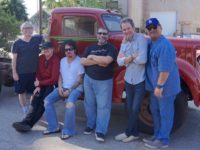Earlier this year, I received an email inquiring about the names of the models in the video for “Pamela,” based on an entry in the Toto Tuesdays series from a few years ago. It may have been tongue in cheek, but I thought I should do my best to at least uncover what I could.
This led me to Nigel Dick, the director of the “Pamela” music video. I submitted the query via his site and to my great surprise he replied factually and succinctly with four names and not much else. As I began to research further about Nigel, what struck me was not only his contributions to the Toto music video catalog but, more significantly, his contributions to the craft of music videos.
“Do They Know It’s Christmas?,” “Sweet Child O’ Mine,” “Baby, One More Time,” “Wonderwall” – these are landmarks in the upper echelons of music video history. His body of work is exceptional, as are the awards he has amassed. According to his bio, Dick has won three MTV awards, two Billboard Awards and three Music Video Producers Association awards. Nigel’s videos have been nominated for a further 20 times – for a MTV award, 26 Much Music Awards, a Grammy and one Brit Award. His many personal nominations include a Cable Ace Award. He was awarded a second Lifetime Achievement Award by the MVPA in May 2012.
We delve into his deep connections with Toto in the following exclusive Something Else! Sitdown. A complete list of his work with the band, along with comments from Nigel, is also included below:
ANTHONY SONEGO: Can you tell me a bit about yourself and how you got into making music videos?
NIGEL DICK: The proper answer to this question would take many pages. However, the short answer is I was a huge music fan who couldn’t get a proper job and reached a low-point playing my guitar for pennies in the Metro in Paris. I returned to London and got myself a gig as a motorcycle messenger for Stiff Records and I’ve been skirting the periphery of showbiz ever since.
ANTHONY SONEGO: How did you become involved with Toto?
NIGEL DICK: They asked David Fincher to pitch on “Pamela” and he turned them down. I was a huge Toto fan and jumped up and down at the back of the class waving my hand in the air and shouting, “Me, me, me! Please sir, let me do it!” – and I got lucky.
ANTHONY SONEGO: Did any of the members give input into the concepts for the songs or concert tour videos?
NIGEL DICK: No, I don’t think so. They have always been cool about “we’ll stick with the music, you stick with the pictures.” And what am I going to do? Tell [David] Paich and [Steve] “Luke” [Lukather] how to write a tune?
ANTHONY SONEGO: Was anyone not interested in the process of making videos?
NIGEL DICK: Jeff [Porcaro] was always very involved, and I think he’d actually directed a video or two before I came on board. I knew it was a process for the rest of the guys, but I never got a feeling they hated it – and they had been doing this for so long, it was just another day with a group-hang and a chance for some laughs. Now Oasis, they hated doing videos!
ANTHONY SONEGO: Tell us a bit about the process of making music videos with Toto I’m imagining it starts with a phone call, then maybe concept discussions face to face, planning, wardrobe, location scouting, lighting, shoot, edit, approval, etc. What are the steps and how long does it usually take?
NIGEL DICK: You’ve described the process of most productions fairly accurately. However with them I would pitch an idea and, when it got approved, it was pretty much up to me to make the rest of it happen with very little interference. They were always very supportive of my decision-making process, and I don’t remember any times where we disagreed much about anything. The timing of a job always varies but I guess a month to six weeks is an average time.
ANTHONY SONEGO: In terms of production and relationship with the band, how does a music video vs concert video project differ?
NIGEL DICK: Chalk and cheese. A video is something which is controlled and you can get a second and third take ’til you get it right. A live show is … live. A video has conceptual elements; a live show usually doesn’t. However in both cases my job is to present the band and the band’s music in the best possible light. For a video, I close my eyes and imagine a cool scenario in which I can place the band for the bucks available. For a live show, I try and learn the show so I know who’s doing what during every bar of the show so I can show the music happening. It pisses me off when I watch a band on TV and they cut to the bass player when the guitar solo comes in. However, when you’re shooting a show with a foreign crew, things do get lost in the translation and you’re dealing with cameramen you’ve never met and accidents do happen.
ANTHONY SONEGO: Was there a preference for concept videos or performances from band members – or yourself?
NIGEL DICK: I always like to see a band performing in a video, and I loved the joy that the band shared when they played, so I think I would have fought back if the band had asked for something entirely conceptual.
ANTHONY SONEGO: What influence, if any, did the record company exert? I know Luke says “Pamela” – and 1988’s The Seventh One – were buried when Sony got new management, but were Sony supportive of the music videos initially because they looked beautifully produced? Or is this a band-directed venture and the record company has nothing to do with it?
NIGEL DICK: From where I stood during that period, the label were heavily involved and their product managers, Betsy Alexander and Peter Fletcher, were very supportive of what I was doing and let me get on with the job. I can’t comment on what was happening further up the food chain, because I was an outside contractor. Other labels I’ve worked with other artists could be incredibly intrusive – to the point where the work was compromised and, on occasion, I would even threaten to walk. But, for me, Sony was never like that and I have remained good friends with all the label folk I met from Sony. The folks I dealt with were all good people who cared and worked hard.
ANTHONY SONEGO: What are some of the changes you have noticed in Toto and their approach to music and concert videos in your time working with them?
NIGEL DICK: Well, they never loved the process. It was a necessary evil for them, and I understood that. The beauty of Toto the band – and as individuals – was that they have always been incredible musicians. It was never about the clothes, the fashion, the image for them. It was always about the groove and the changes and the perfect take. But my job was to somehow give them access to the people beyond the pure musicologist-type fan, and make their music accessible to the boy/girl on the street. I’ll let you decide if I ever did that.
ANTHONY SONEGO: What is your favorite Toto music video and why?
NIGEL DICK: “Straight for the Heart.” No question. It was a joy to shoot. Just look at their faces and how much fun they’re having. I loved the story too, and felt it looked beautiful. The irony is that the band didn’t like it at all, but they completely supported my vision and didn’t change a frame and went with the video. If I ever need a pick me up, I check it out on YouTube and remind myself of how much fun it has been to work with them.
ANTHONY SONEGO: I went back and watched this with fresh eyes and it’s clear you love to see the band enjoying themselves as they play. Very natural. Did you notice that Joseph [Williams]’ go-to movement with excitement is to kick a chair? Was that your direction or does he do this impulsively?
NIGEL DICK: Yes, I directed him. But it’s so long ago that I had to go back to my original files and check my storyboards to make sure. I remember giving Joe permission to trash the room – which was a set, built in a huge hangar – and we did not have the time or the resources to rebuild the room for second takes so each shot was a one-off, which was a bit nerve racking. Obviously, the pictures Joe sifts through at the start and the big picture of the girl on the wall are stills from the “Pamela” shoot. We shot those girls on a Friday, the band performance for both songs on Saturday, and the stuff with Joe in the room on Sunday. That meant that the stills guy had to develop and print his film overnight on Friday, I had to choose the stills Saturday morning and then he had to print up the 10-by-8s, so that the art department could work like crazy through Saturday afternoon and Saturday night to create that wall of photocopies. This was before lap-tops, cell-phones and even digital photography. This is the part of film making I really get off on – the collision of art and practical and logistical stuff. You have to have a grasp of both, so you can do your job well.
ANTHONY SONEGO: Absolutely! And, that’s a fantastic way to encapsulate it – the collision of art and logistics. By way of contrast, what was the most difficult Toto music video to complete? I’m imagining it will be “Don’t Chain My Heart,” after the untimely death of Jeff Porcaro.
NIGEL DICK: Shooting that video was hell. I cried through every step of the process – and we had to shoot it twice, because the first time round the film was underexposed. I don’t think any job I have done has ever torn me up as bad as that one did.
ANTHONY SONEGO: Any closing comments you’d like to share?
NIGEL DICK: I am very lucky. I have shot hundreds, literally hundreds of artists. I can number about five who have become good friends and who have welcomed me into their lives as a friend, and not just the Annoying Bloke Who Makes Videos For Us – and Toto is top of that short list. Doing this job is very weird: You are the bird pulling ticks out of the elephants back. Without the elephant, you don’t have a job. But they’ve always treated me with respect, and I’m very grateful for that – and Lukather is the only man who has ever kissed me. I don’t think he kisses people he doesn’t like.
NIGEL DICK DISCUSSES HIS TOTO MUSIC VIDEOS
“PAMELA,” 1988. Project No. 179: “The greatest bunch of guys I have ever worked with – period.”
“I CAN’T STOP LOVING YOU,” 1988. Project No. 180: “Watch this song title.”
“STRAIGHT FOR THE HEART,” 1988. Project No. 187: “The band hated the idea, but to their credit let me shoot it anyway. And it’s still a personal favorite.”
“OUT OF LOVE,” 1990. Project No. 246: “The old barman had a story to tell. Wish I could remember what it was.”
“CAN YOU HEAR WHAT I’M SAYING,” 1990. Project No. 247: “Improved flags motif.”
TOTO IN PARIS, 1991. Project No. 269: “Call me uncool but I tell you, Toto rocks!”
TOTO IN EUROPE, 1991. Project No. 270: “At the gig in Nice, Jeff stopped the show and swapped his drumsticks for a T-shirt worn by a kid seven rows back. In front of the whole crowd, he gave me the T-shirt which reads DICK MACUMBA. You can see the T-shirt on my Nigel Dick resume page.
“DON’T CHAIN MY HEART,” 1992. Project No. 291: Jeff and I laughed as we discussed ideas for the video, and for some reason I told him how much I valued his friendship and how I admired him. Two hours later, he had a heart attack and died. God bless you, Jeff.”
TAMBU EPK, 1995. Project No. 314: “‘Baby He’s Your Man’ – who says a blue man can’t sing the whites?”
TOTO TOUR EPK, 2011. Project No. 548: “They played live versions of both df179 [“Pamela”] & df180 [“I Can’t Stop Lovin’ You”].”
TOTO LIVE CONCERT, 2011. Project No. 552: “Calling the shots on this show was the fastest two hours of my life.”
TOTO SIZZLE REEL, 2012. Project No. 574: “Six Grammys and 35 million albums – not bad for a bunch of schoolkids from the valley.”
TOTO LIVE DVD, 2018. Project No. 688: “Including one-shoot day that took us through five countries, which beats my Tour de France record.
- Toto, “Spanish Sea” from ‘Old Is New’ (2018): Toto Tuesdays - June 15, 2021
- Toto, “Devil’s Tower” from ‘Old Is New’ (2018): Toto Tuesdays - May 11, 2021
- Toto, “Alone” from ‘Old Is New’ (2018): Toto Tuesdays - April 27, 2021




